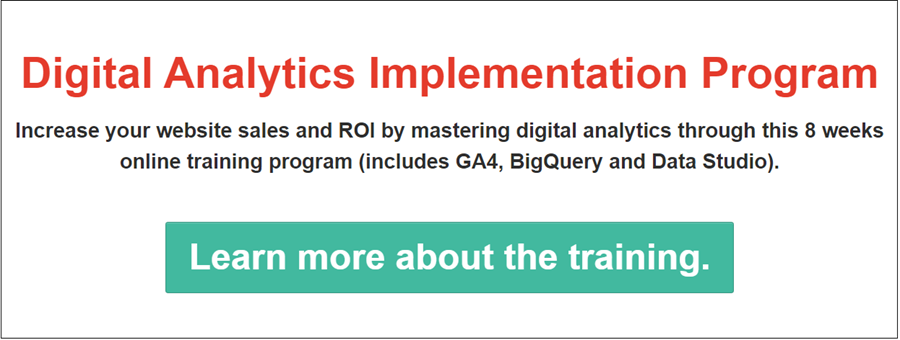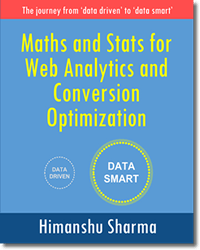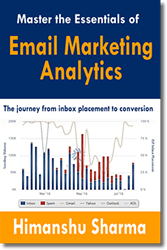Why your website conversion rate is destined to remain poor
Last Updated: September 5, 2023

70-80% of your website visitors will abandon your shopping cart today. It is inevitable.
Only around 20% will make a purchase, the rest 80% are most likely to abandon the checkout.
So the question is, what you are going to do about that. Will you let them go, just like that and instead focus on bringing more new traffic to your website?
You spent so much time and money to bring them to your website. They were so close to making their first/second/third… purchase. Will you let them go, just like that?
… No. You retarget them. You use the fear of missing out. You use special discounts and offers to entice them. You retarget them on Twitter, Facebook, Instagram, Gmail, Yahoo mail, Skype, Email and every conceivable marketing platform used by your target audience.
You use every trick in the remarketing book to bring them back to your website and persuade them to complete the purchase. There are more than 100 different ways to remarket to your target audience. So you can never really run out of remarketing ideas.
This is the application of the principle of ‘factor sparsity’ or 80/20 rule. Business who follow this rule tend to have high conversion rate and high customer lifetime value. Business who don’t, tend to have poor conversion rate and poor customer lifetime value.
80% of your output come from 20% of your efforts.
80% of your sales come from 20% of your marketing efforts.
And these marketing efforts should be your remarketing efforts.
People who have already visited your website, people who have already shown interest in making a purchase are more likely to convert on subsequent visits than the people who have never been exposed to your brand.
Because of this reason, the cost per acquisition (CPA) of a remarketing audience tends to be lower than the CPA of a brand new customer.
Yet majority of businesses spend 80% of their marketing budget on acquiring new website visitors/customers and only 20% in bringing back the old website visitors/customers.
When in fact it should be the opposite.
Spend 80% of your marketing budget on bringing back the old website visitors/customers and only 20% on acquiring new website visitors/customers.
Unless you are brand new business or your business model does not really benefit from repeat customers, you don’t need tons of new traffic on consistent basis.
You most likely, already getting lot of traffic to your website. Even 10k visits a month is not a bad traffic.
For most ecommerce websites, traffic is not really a problem but poor ecommerce conversion rate is.
And their ecommerce conversion rates are destined to remain poor (10% or less), if they choose not to spend significant amount of their marketing budget and resources on running remarketing campaigns.
“Hold on a second, 10% ecommerce conversion rate is pretty good”. You may say. ………No. Not really.
It is just that we have lower our expectations over time.
Websites which are well optimised for conversions, which spent lot of resources on remarketing tend to have an ecommerce conversion rate higher than 20%.
I do not have vast amount of data to backup this claim but the ecommerce websites I have analyzed, which are very profitable, all tend to have ecommerce conversion rate higher than 20%. And I sincerely believe, they can still do much better.
If you can’t convert even 10% of your website traffic into sales, then something is really wrong with your marketing and optimization.
I want you to aim high and do not settle for just 2-3% ecommerce conversion rate.
There is a common misconception that remarketing is all about bombarding your target audience with promotional messages and therefore if done in excess can create bad user experience and lost customers.
Every time you engage with your target audience (like providing a value through article or video) you are remarketing your brand.
When people know you and trust you they will jump through loops to buy from you. You don’t have to worry about perfecting your ad copy, perfecting your headlines or ‘buy now’ button.
Your customers will even tell you that they really want to buy XYZ product but your shopping cart is throwing error. You can’t expect such type of behavior from a brand new prospect.
Most of the conversion optimization today is geared towards converting brand new website visitors/customers into sales. When it should be geared towards converting existing website visitors/customers into sales because they are more likely to convert.
Following are the key benefits of remarketing:
#1 It lowers your cost per acquisition over time. Thus both your return on investment (ROI) and return on advertising spend increases and you become more profitable over time.
#2 It increases your customer lifetime value. Your customers are going to make repeated purchase only if you remain on their radar. Otherwise they will forget who you are in couple of weeks. Remarketing helps in keeping your brand on their radar.
#3 It increases both your sales and average order value. It is a well documented fact that repeat customers are more profitable than new customers. They tend to purchase more often and they tend to purchase high price items.
#4 Repeat customers are more likely to recommend your brand to their friends and colleagues. Thus they help you in providing word of mouth publicity and free referral/viral traffic.
#5 You can considerable decrease your lost revenue (i.e. the amount of sales lost if not recovered in a timely manner through remarketing). The sales recovered through remarketing is called ‘recovered revenue’. Majority of businesses do not focus on increasing their recovered revenue (which is a very important KPI) and therefore tends to have poor conversion rate.
Last Updated: September 5, 2023

70-80% of your website visitors will abandon your shopping cart today. It is inevitable.
Only around 20% will make a purchase, the rest 80% are most likely to abandon the checkout.
So the question is, what you are going to do about that. Will you let them go, just like that and instead focus on bringing more new traffic to your website?
You spent so much time and money to bring them to your website. They were so close to making their first/second/third… purchase. Will you let them go, just like that?
… No. You retarget them. You use the fear of missing out. You use special discounts and offers to entice them. You retarget them on Twitter, Facebook, Instagram, Gmail, Yahoo mail, Skype, Email and every conceivable marketing platform used by your target audience.
You use every trick in the remarketing book to bring them back to your website and persuade them to complete the purchase. There are more than 100 different ways to remarket to your target audience. So you can never really run out of remarketing ideas.
This is the application of the principle of ‘factor sparsity’ or 80/20 rule. Business who follow this rule tend to have high conversion rate and high customer lifetime value. Business who don’t, tend to have poor conversion rate and poor customer lifetime value.
80% of your output come from 20% of your efforts.
80% of your sales come from 20% of your marketing efforts.
And these marketing efforts should be your remarketing efforts.
People who have already visited your website, people who have already shown interest in making a purchase are more likely to convert on subsequent visits than the people who have never been exposed to your brand.
Because of this reason, the cost per acquisition (CPA) of a remarketing audience tends to be lower than the CPA of a brand new customer.
Yet majority of businesses spend 80% of their marketing budget on acquiring new website visitors/customers and only 20% in bringing back the old website visitors/customers.
When in fact it should be the opposite.
Spend 80% of your marketing budget on bringing back the old website visitors/customers and only 20% on acquiring new website visitors/customers.
Unless you are brand new business or your business model does not really benefit from repeat customers, you don’t need tons of new traffic on consistent basis.
You most likely, already getting lot of traffic to your website. Even 10k visits a month is not a bad traffic.
For most ecommerce websites, traffic is not really a problem but poor ecommerce conversion rate is.
And their ecommerce conversion rates are destined to remain poor (10% or less), if they choose not to spend significant amount of their marketing budget and resources on running remarketing campaigns.
“Hold on a second, 10% ecommerce conversion rate is pretty good”. You may say. ………No. Not really.
It is just that we have lower our expectations over time.
Websites which are well optimised for conversions, which spent lot of resources on remarketing tend to have an ecommerce conversion rate higher than 20%.
I do not have vast amount of data to backup this claim but the ecommerce websites I have analyzed, which are very profitable, all tend to have ecommerce conversion rate higher than 20%. And I sincerely believe, they can still do much better.
If you can’t convert even 10% of your website traffic into sales, then something is really wrong with your marketing and optimization.
I want you to aim high and do not settle for just 2-3% ecommerce conversion rate.
There is a common misconception that remarketing is all about bombarding your target audience with promotional messages and therefore if done in excess can create bad user experience and lost customers.
Every time you engage with your target audience (like providing a value through article or video) you are remarketing your brand.
When people know you and trust you they will jump through loops to buy from you. You don’t have to worry about perfecting your ad copy, perfecting your headlines or ‘buy now’ button.
Your customers will even tell you that they really want to buy XYZ product but your shopping cart is throwing error. You can’t expect such type of behavior from a brand new prospect.
Most of the conversion optimization today is geared towards converting brand new website visitors/customers into sales. When it should be geared towards converting existing website visitors/customers into sales because they are more likely to convert.
Following are the key benefits of remarketing:
#1 It lowers your cost per acquisition over time. Thus both your return on investment (ROI) and return on advertising spend increases and you become more profitable over time.
#2 It increases your customer lifetime value. Your customers are going to make repeated purchase only if you remain on their radar. Otherwise they will forget who you are in couple of weeks. Remarketing helps in keeping your brand on their radar.
#3 It increases both your sales and average order value. It is a well documented fact that repeat customers are more profitable than new customers. They tend to purchase more often and they tend to purchase high price items.
#4 Repeat customers are more likely to recommend your brand to their friends and colleagues. Thus they help you in providing word of mouth publicity and free referral/viral traffic.
#5 You can considerable decrease your lost revenue (i.e. the amount of sales lost if not recovered in a timely manner through remarketing). The sales recovered through remarketing is called ‘recovered revenue’. Majority of businesses do not focus on increasing their recovered revenue (which is a very important KPI) and therefore tends to have poor conversion rate.
My best selling books on Digital Analytics and Conversion Optimization
Maths and Stats for Web Analytics and Conversion Optimization
This expert guide will teach you how to leverage the knowledge of maths and statistics in order to accurately interpret data and take actions, which can quickly improve the bottom-line of your online business.
Master the Essentials of Email Marketing Analytics
This book focuses solely on the ‘analytics’ that power your email marketing optimization program and will help you dramatically reduce your cost per acquisition and increase marketing ROI by tracking the performance of the various KPIs and metrics used for email marketing.
Attribution Modelling in Google Analytics and BeyondSECOND EDITION OUT NOW!
Attribution modelling is the process of determining the most effective marketing channels for investment. This book has been written to help you implement attribution modelling. It will teach you how to leverage the knowledge of attribution modelling in order to allocate marketing budget and understand buying behaviour.
Attribution Modelling in Google Ads and Facebook
This book has been written to help you implement attribution modelling in Google Ads (Google AdWords) and Facebook. It will teach you, how to leverage the knowledge of attribution modelling in order to understand the customer purchasing journey and determine the most effective marketing channels for investment.







